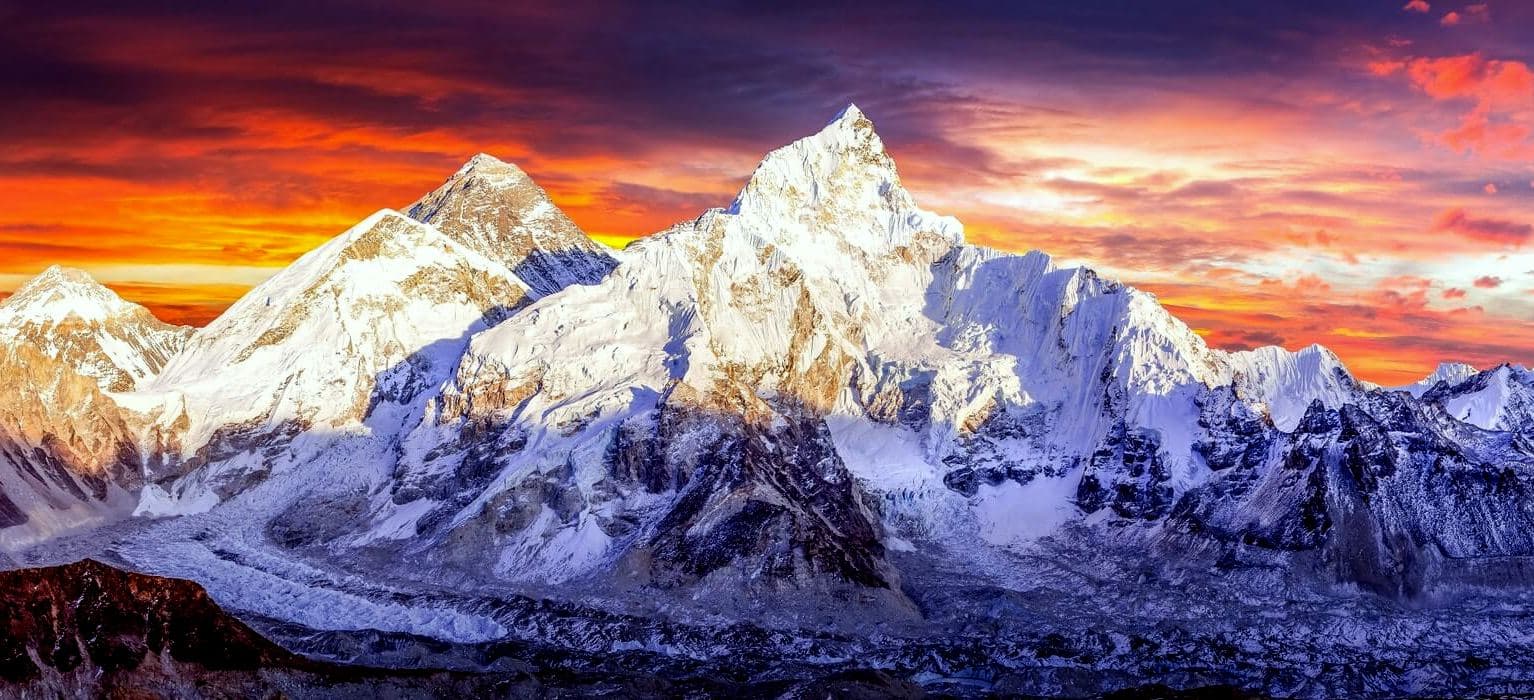Lobuche Peak Climbing with Everest Base Camp
Lobuche Peak Climbing with Everest Base Camp is a thrilling and rewarding adventure that combines the iconic Everest Base Camp trek with the exhilaration of summiting Lobuche Peak. This expedition offers the best of both worlds, allowing you to immerse yourself in the natural beauty of the Everest region while testing your climbing skills on a challenging peak.
The journey begins in Kathmandu, where you'll take a short flight to Lukla, the gateway to the Everest region. From there, you'll embark on the classic Everest Base Camp trek, following a trail that winds through picturesque Sherpa villages, lush forests, and awe-inspiring mountain vistas. Along the way, you'll have the opportunity to acclimatize gradually, ensuring your body adjusts to the increasing altitude. As you trek toward Everest Base Camp, you'll be captivated by the breathtaking scenery, including close-up views of towering peaks like Ama Dablam, Lhotse, and Nuptse. Reaching Everest Base Camp, situated at the foot of the majestic Mount Everest, is a monumental achievement in itself. Standing amidst the backdrop of the world's highest peak, you'll soak in the rich mountaineering history and the vibrant atmosphere of the camp.
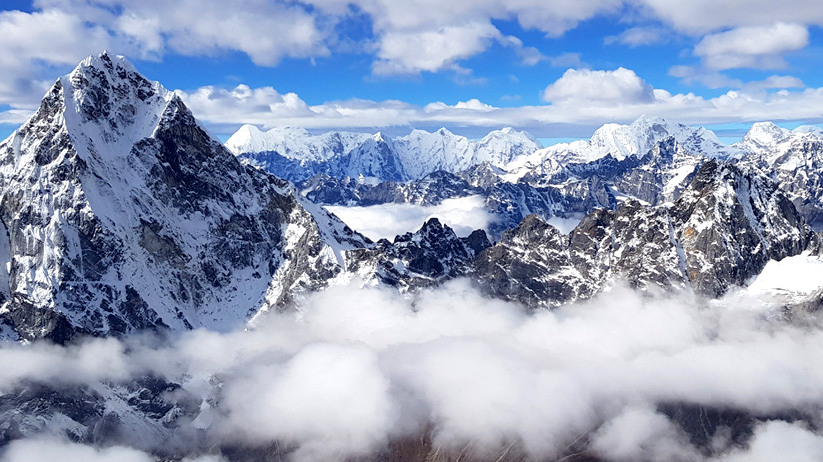
After spending time at Everest Base Camp, the focus shifts to Lobuche Peak. With its two faces, Lobuche East (6,119m) and Lobuche West (6,145m), climbers generally choose the East Peak for its slightly easier ascent. The climb to Lobuche Peak requires technical skills and physical endurance, as you navigate through icy slopes, steep ridges, and possibly some crevasses. With the guidance of experienced Sherpa guides, you'll progress toward the summit, taking in awe-inspiring views of the surrounding Himalayan peaks. Standing atop Lobuche Peak is a moment of triumph and a realization of your physical and mental capabilities. The panoramic vistas of Everest, Lhotse, Makalu, and other towering peaks will leave you in awe of the grandeur of the Himalayas. The sense of accomplishment and the stunning beauty of the surroundings create memories that will last a lifetime.
You'll return to Lukla after the thrilling journey is over, savoring your last minutes in the high mountains before flying back to Kathmandu. Along with being physically demanding, this journey offers a chance to learn about the distinctive Sherpa culture, observe their customs, and develop a greater appreciation for the mountains they call home.
Highlights of the Lobuche Peak Climbing with Everest Base Camp
The Lobuche Peak Climbing with Everest Base Camp expedition is filled with remarkable highlights that make it a truly unforgettable adventure. Here are some of the key highlights of this incredible journey:
- Everest Base Camp: Reach the base camp of the world's highest peak.
- Lobuche Peak Summit: Conquer the challenging slopes and reach the summit of Lobuche Peak.
- Scenic Beauty: Immerse yourself in breathtaking landscapes, from lush forests to majestic mountain vistas.
- Sherpa Culture: Experience the warm hospitality and rich traditions of the Sherpa community.
- Acclimatization: Take necessary rest days for acclimatization to the increasing altitude.
- Kala Patthar Viewpoint: Climb to Kala Patthar for stunning sunrise views of Everest and surrounding peaks.
- Personal Growth: Challenge yourself and achieve a sense of personal accomplishment.
- Adventure Combo: Combine the thrill of peak climbing with the renowned Everest Base Camp trek.
Difficulty Level of the Lobuche Peak Climbing with Everest Base Camp
The Lobuche Peak Climbing with Everest Base Camp expedition is considered to have a moderate to challenging difficulty level. Here are some factors that contribute to the overall challenge of the expedition:
Altitude
Altitude is a significant consideration during the Lobuche Peak Climbing with Everest Base Camp expedition. As you trek higher into the Khumbu region, the altitude increases, resulting in reduced oxygen levels. Adequate acclimatization is crucial to minimize the risk of altitude sickness, and the expedition itinerary includes rest days to allow your body to adjust. Altitude-related challenges, such as thinning air and physical exertion, can affect climbers. Understanding the symptoms of altitude sickness, following safety precautions, and maintaining good physical fitness are important. Some climbers opt for altitude training to help their bodies adapt to lower oxygen levels. By being aware of the risks, acclimatizing properly, and listening to your body, you can ensure a safer and more successful climb at high altitudes.
Technical Skills
Technical skills are essential for the Lobuche Peak Climbing with Everest Base Camp expedition. Climbers should have a basic understanding of mountaineering techniques, including the use of crampons, ice axes, and ropes. Familiarity with roped travel and glacier navigation is beneficial for tackling the steep ridges, snow slopes, and potential crevasses encountered during the climb. It is important to be comfortable on icy and challenging terrain and possess the ability to assess and mitigate risks in a mountainous environment. While the technical difficulty of Lobuche Peak is manageable for climbers with varying skill levels, prior climbing experience and training can greatly enhance safety and success on the expedition. Working with experienced guides and Sherpas who possess technical expertise can provide valuable support and guidance throughout the climb.
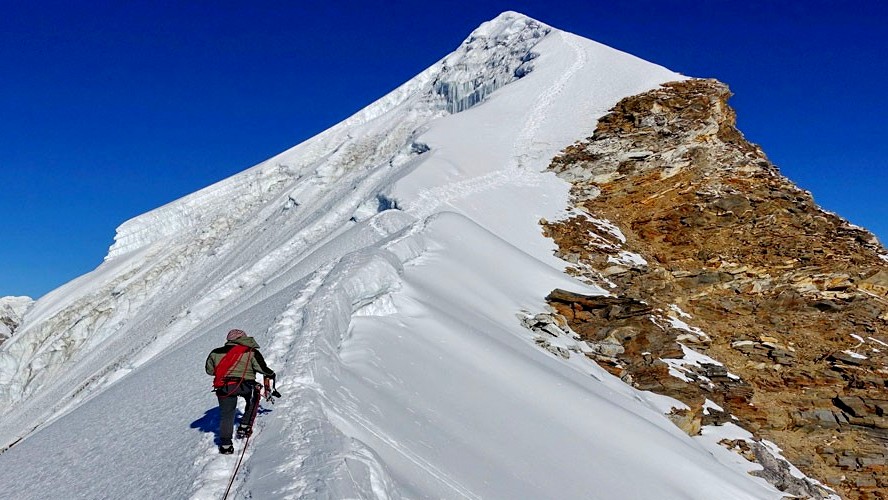
Duration and Endurance
The Lobuche Peak Climbing with Everest Base Camp expedition requires significant duration and endurance. The entire expedition typically takes around 20 to 22 days to complete. This includes the trek to Everest Base Camp, acclimatization days, and the ascent of Lobuche Peak. Trekking to Everest Base Camp involves long hours of walking, often on challenging terrain, requiring good endurance. Climbers should be prepared for multiple days of continuous trekking, gradually gaining altitude. The climb to Lobuche Peak requires physical stamina to tackle steep slopes and potentially adverse weather conditions. Building endurance through regular exercise and training prior to the expedition can greatly contribute to a successful and enjoyable experience. It is important to pace oneself, take rest days for acclimatization, and maintain a steady and sustainable level of endurance throughout the duration of the expedition.
Weather and Climate
Weather and climate play a crucial role in the Lobuche Peak Climbing with Everest Base Camp expedition. The Everest region experiences variable weather conditions throughout the year. Climbers can expect cold temperatures, especially at higher elevations, and should be prepared with appropriate clothing and gear to withstand freezing temperatures. The weather can change rapidly, and climbers should be ready for sudden weather shifts, including snowfall, strong winds, and fog. It is important to stay updated on weather forecasts and plan accordingly. Adapting to changing weather conditions and being flexible with the itinerary is essential for a safe and successful climb. Despite the challenging weather, clear and calm days offer stunning views of the surrounding Himalayan peaks, making the effort and preparation worthwhile.
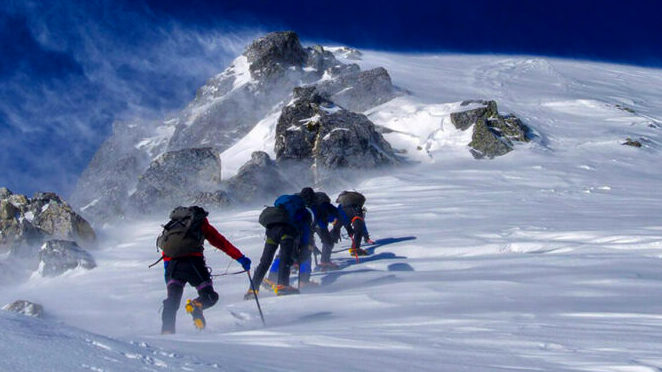
Preparation of the Lobuche Peak Climbing with Everest Base Camp
Preparing for the Lobuche Peak Climbing with Everest Base Camp expedition requires careful planning and physical readiness. Here are some key aspects to consider during your preparation:
- Focus on physical fitness through regular exercise, including hiking, running, and strength training.
- Gain prior climbing experience and familiarize yourself with mountaineering techniques.
- Understand the risks of altitude sickness and plan for gradual acclimatization during the expedition.
- Prepare a comprehensive gear and equipment checklist, including appropriate clothing, footwear, and climbing gear.
- Obtain the necessary permits and documentation, such as Sagarmatha National Park Permit and climbing permits.
- Mentally prepare yourself for the challenges of high-altitude climbing and develop a positive mindset.
- Train with a weighted backpack to build strength and stamina for carrying gear during the trek and climb.
- Seek advice and guidance from experienced climbers or climbing agencies.
- Stay updated with current regulations and procedures for the Lobuche Peak Climbing with Everest Base Camp expedition.
- Prioritize safety, listen to your body, and enjoy the journey in the magnificent Himalayas.
By adequately preparing yourself physically, mentally, and logistically, you can ensure a safe and successful Lobuche Peak Climbing with the Everest Base Camp expedition. Remember to prioritize your safety, listen to your body, and enjoy the incredible journey that awaits you in the Himalayas.
Permits for the Lobuche Peak Climbing with Everest Base Camp
Here are the permits required to start the Lobuche Peak Climbing with Everest Base Camp expedition:
Sagarmatha National Park Permit: This permit is mandatory for entering the Sagarmatha National Park, which is home to Everest Base Camp and the surrounding area. The permit aims to conserve the natural and cultural heritage of the region.
Khumbu Rural Municipality Permit: This permit is required to enter the Khumbu region, which includes popular trekking destinations like Everest Base Camp and Lobuche Peak. It helps in supporting the local communities and preserving the region's resources.
TIMS Card (Trekkers' Information Management System): The TIMS Card is required for all trekkers entering the Everest region, including those heading to Everest Base Camp. It helps in tracking trekkers, ensuring their safety, and providing necessary information.
Climbing Permit: A climbing permit is necessary specifically for Lobuche Peak Climbing. The permit is issued by the Nepal Mountaineering Association (NMA) and includes the fees for climbing Lobuche Peak.
It is important to obtain these permits before commencing the expedition. The permits can be acquired through a registered trekking agency in Nepal, and they require the necessary documentation, passport details, and payment of the respective fees. It is advisable to check the latest permit requirements and regulations before embarking on the Lobuche Peak Climbing with Everest Base Camp expedition.
Best Time for the Lobuche Peak Climbing with Everest Base Camp
The Lobuche Peak Climbing with Everest Base Camp expedition can be undertaken during different seasons, each offering its own advantages and considerations. Here's a breakdown of the best time to embark on the expedition in each season:
Spring (March to May)
Spring is considered the best season for the Lobuche Peak Climbing with the Everest Base Camp expedition. The weather is generally stable, with mild temperatures and clear skies. The spring season offers beautiful views of blooming rhododendron forests along the trekking trail. However, this is also a popular season, and the trails can be crowded.
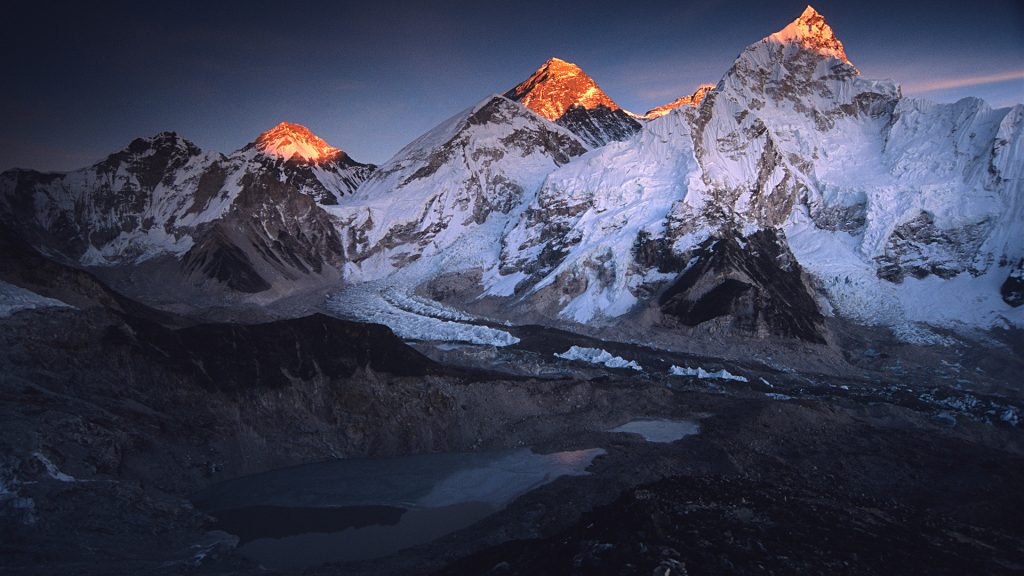
Daytime temperatures: 10°C to 20°C (50°F to 68°F)
Nighttime temperatures at lower elevations: -5°C to 5°C (23°F to 41°F)
Nighttime temperatures at higher elevations: -10°C to -5°C (14°F to 23°F)
Summer/Monsoon (June to August)
The summer or monsoon season in Nepal brings heavy rainfall, making it the least favorable time for the expedition. The trails can be muddy, and there is a higher risk of landslides. However, this season sees fewer trekkers, and the landscapes are lush and green. It can be a suitable time for those seeking solitude and willing to deal with the challenges of rain.
Daytime temperatures: 15°C to 25°C (59°F to 77°F)
Nighttime temperatures at lower elevations: 5°C to 10°C (41°F to 50°F)
Nighttime temperatures at higher elevations: 0°C to -5°C (32°F to 23°F)
Autumn (September to November)
Autumn is another excellent season for the Lobuche Peak Climbing with the Everest Base Camp expedition. The weather is generally stable, with clear skies and moderate temperatures. The trails are dry and offer spectacular views of the surrounding mountains. Autumn is the busiest season for trekking in Nepal, so expect more trekkers on the trail.
Daytime temperatures: 10°C to 20°C (50°F to 68°F)
Nighttime temperatures at lower elevations: -5°C to 5°C (23°F to 41°F)
Nighttime temperatures at higher elevations: -10°C to -5°C (14°F to 23°F)
Winter (December to February)
Winter is a challenging but rewarding season for the Lobuche Peak Climbing with the Everest Base Camp expedition. The temperatures are cold, especially at higher altitudes, and there may be occasional snowfall. However, the trails are less crowded, and the mountain views are breathtaking. Adequate cold-weather gear and preparations are necessary to tackle the cold conditions.
Daytime temperatures: 5°C to 15°C (41°F to 59°F)
Nighttime temperatures at lower elevations: -10°C to 0°C (14°F to 32°F)
Nighttime temperatures at higher elevations: -20°C to -10°C (-4°F to 14°F)
Travel Insurance for the Lobuche Peak Climbing with Everest Base Camp
Having travel insurance is highly recommended for the Lobuche Peak Climbing with Everest Base Camp expedition. Here are some key points to consider regarding travel insurance:
- Choose a travel insurance policy that offers comprehensive coverage, including medical expenses, emergency evacuation, trip cancellation or interruption, and loss or theft of personal belongings.
- Ensure that the policy specifically covers high-altitude trekking and mountaineering activities, as these are involved in the Lobuche Peak Climbing with Everest Base Camp expedition.
- Make sure the insurance provides coverage for emergency helicopter evacuation, as it may be necessary in case of altitude sickness, injuries, or other medical emergencies in remote mountainous areas.
- Confirm that the policy covers medical expenses, including doctor visits, medications, and hospitalization, considering the limited medical facilities in the Everest region.
- Check if the insurance offers coverage for trip cancellation or interruption due to unforeseen circumstances, such as flight cancellations, natural disasters, or personal emergencies.
- Verify that adventure activities like trekking and climbing at high altitudes are not excluded from the insurance coverage.
- Ensure that the policy duration covers the entire expedition, including the trekking period, climbing period, and any additional days for acclimatization or unforeseen delays.
- Read and understand the policy details, including coverage limits, deductibles, exclusions, and claim procedures, to ensure you have the necessary coverage for your needs.
- Obtain travel insurance before embarking on the expedition and carry a copy of the policy and contact information with you during the journey.
- Consider consulting insurance providers specializing in adventure travel or mountaineering to find a policy that meets the specific requirements of the Lobuche Peak Climbing with the Everest Base Camp expedition.
Having adequate travel insurance will provide peace of mind and financial protection in case of any unforeseen events or emergencies during your expedition.
Checklist for the Lobuche Peak Climbing with Everest Base Camp
Here's a checklist for the Lobuche Peak Climbing with Everest Base Camp expedition:
Trekking Gear
- Sturdy and comfortable trekking boots
- Backpack with rain cover
- Trekking pants and shorts
- Base layer tops and bottoms (synthetic or merino wool)
- Insulating layers (fleece or down jacket)
- Waterproof and windproof jacket
- Warm hat and gloves
- Sunglasses with UV protection
- Trekking poles
- Sleeping bag suitable for cold temperatures
- Headlamp with extra batteries
- Water bottle or hydration bladder
Climbing Equipment
- Mountaineering boots
- Crampons
- Ice axe
- Climbing harness
- Carabiners and slings
- Helmet
- Prusik cords
- Ascenders and descenders
- Climbing gloves
- Mountaineering backpack
Clothing
- Thermal base layers
- Mid-layer tops and bottoms
- Insulated jacket or down suit for the summit push
- Waterproof and windproof pants
- Gaiters
- Mountaineering socks
- Balaclava or face mask
- Warm mittens or gloves
Personal Items
- Personal toiletries (toothbrush, toothpaste, soap, etc.)
- Sunscreen (SPF 30+)
- Lip balm with SPF
- Personal medications and first aid kit
- Wet wipes and hand sanitizer
- Quick-drying towel
- Camera and extra batteries
- Power bank or portable charger
- Travel adapter
Documents
- Valid passport with necessary visas
- Travel insurance documents
- Permits (Sagarmatha National Park, Khumbu Rural Municipality, TIMS Card, Climbing Permit)
Miscellaneous
- Cash (Nepalese Rupees) and/or credit/debit cards
- Snacks and energy bars
- Duct tape and ziplock bags
- Trekking maps and guidebooks
- Multi-tool or knife
- Whistle
- Personal locator beacon (optional)
- A communication device (satellite phone or walkie-talkie, if required)
It's important to note that this checklist is a general guide, and you may have additional specific requirements based on your personal preferences and the recommendations of your trekking agency or guide. Ensure that you pack according to the season and weather conditions, and consider the weight limitations imposed by airlines or porters.
Tips for the Lobuche Peak Climbing with Everest Base Camp
Here are some useful tips for the Lobuche Peak Climbing with Everest Base Camp:
- Prioritize physical fitness and engage in regular exercise and training.
- Acclimatize properly to the increasing altitude by ascending gradually and taking rest days.
- Stay hydrated and maintain a balanced diet throughout the journey.
- Hire a professional guide or join an experienced trekking agency.
- Pack lightweight and essential items, following the provided checklist.
- Prioritize safety at all times and follow the instructions of your guide.
- Prepare yourself mentally for the challenges of the expedition.
- Respect the environment and local culture by practicing responsible trekking.
- Stay informed about the weather conditions and be prepared for changes.
- Embrace the experience and enjoy the journey, savoring the unique moments.
By keeping these tips in mind, you can have a safe and enjoyable Lobuche Peak Climbing with the Everest Base Camp expedition.
FAQs for the Lobuche Peak Climbing with Everest Base Camp
Q: How difficult is the Lobuche Peak Climbing with the Everest Base Camp expedition?
A: The Lobuche Peak Climbing with Everest Base Camp expedition is considered a challenging trek and climb. It requires a good level of physical fitness, endurance, and previous trekking experience at high altitudes. Technical climbing skills and experience are also recommended.
Q: What is the best time to undertake the Lobuche Peak Climbing with Everest Base Camp expedition?
A: The best time for the Lobuche Peak Climbing with Everest Base Camp expedition is during the pre-monsoon (spring) season (March to May) and post-monsoon (autumn) season (September to November). These months offer stable weather conditions, clear skies, and moderate temperatures for trekking and climbing.
Q: Do I need prior climbing experience to attempt Lobuche Peak?
A: While prior climbing experience is beneficial, it is not mandatory for Lobuche Peak Climbing. However, it is recommended to have some basic mountaineering skills, including the use of climbing equipment, familiarity with roped travel, and knowledge of basic climbing techniques. Proper training and guidance from experienced climbers or guides are essential.
Q: What permits are required for the Lobuche Peak Climbing with Everest Base Camp expedition?
A: The permits required for the expedition include the Sagarmatha National Park Permit, Khumbu Rural Municipality Permit, TIMS (Trekkers' Information Management System) Card, and the Climbing Permit for Lobuche Peak. These permits need to be obtained before the trek and climbing activities.
Q: How long does the Lobuche Peak Climbing with Everest Base Camp expedition take?
A: The duration of the expedition varies depending on the chosen itinerary. On average, the trek to Everest Base Camp takes around 12-14 days, while the Lobuche Peak Climbing portion adds an additional 3-4 days. It is recommended to allocate a total of 17-20 days for the entire expedition, considering acclimatization and possible weather delays.
Q: What type of accommodation is available during the expedition?
A: Accommodation during the expedition is mainly in tea houses or lodges along the trekking route. These are basic guest houses providing meals and a place to sleep. However, during the climbing phase, camping accommodation is set up at designated base camps or high camps.
Q: Is altitude sickness a concern during the Lobuche Peak Climbing with Everest Base Camp expedition?
A: Yes, altitude sickness is a potential concern during the expedition. Proper acclimatization, gradual ascent, staying hydrated, and recognizing the symptoms of altitude sickness are crucial. It is recommended to consult with a healthcare professional and follow their advice for preventing and managing altitude sickness.
Q: What kind of training and preparation should I undertake before the expedition?
A: Preparing for the expedition involves a combination of cardiovascular exercises, strength training, and endurance-building activities. Focus on hiking, climbing stairs, running, and carrying a backpack to simulate the conditions you will encounter during the expedition. Additionally, practice using mountaineering equipment and familiarize yourself with basic climbing techniques.
Similarly other 6000-meter peaks for Climbing and Expedition Packages in Nepal
Mt Ama Dablam Expedition (6,812 m)
Island Peak Expedition (6,160 m)
Mera Peak Climbing (6,476 m)
Chulu West Peak Climbing (6,419 m)
Pisang Peak Climbing (6,091 m)
Singu Chuli Peak Climbing (6,501 m)
8000-meter Mountain Expedition in Nepal
Makalu Expedition (8,463m)
Manaslu Expedition (8,163 m)
Kanchenjunga Expedition (8,586 m)
Lhotse Expedition (8,516 m)
Mt. Everest Expedition (8848.86 m)
Dhaulagiri Expedition (8,167 m)
7000-meter peaks for Climbing and Expedition in Nepal
Gangapurna Expedition (7,455 m)
Pumori Expedition (7,145 m)
Tilicho Peak Expedition (7,134 m)
Annapurna South Expedition (7,219 m)
If you need any further information, please contact us by email: at [email protected], Phone: at +977- 985 100 5129 (WhatsApp)
#Tags
Tripadvisor
5.0928 reviewsGoogle
4.8114 reviewsFacebook
4.1 recommend44 ReviewsTrustpilot
4.1 Great(5 reviews)- Trusted by50K plus traveller

